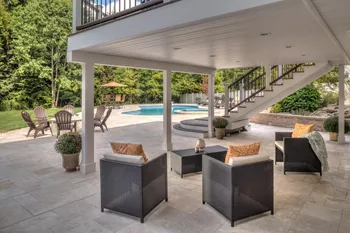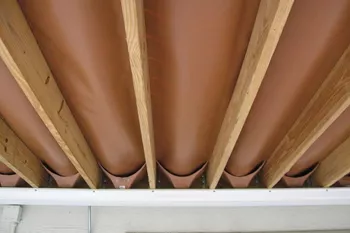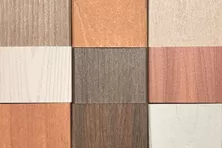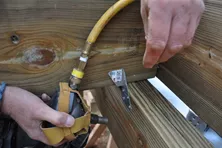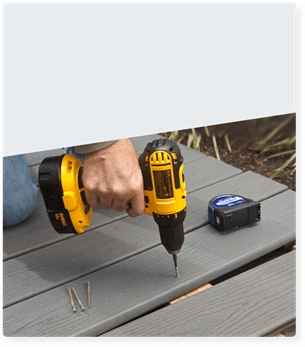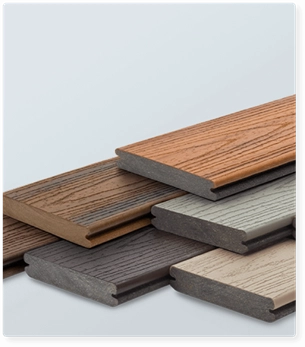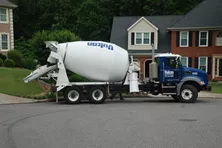Waterproof Decking Materials & Options
While water gives life, it also destroys, especially when it comes to construction. In fact, your home may have no greater enemy than water.
Decks are typically designed with spacing between boards to help create drainage. While draining can be helpful and prevent water from pooling on your deck, the spacing may allow water to seep underneath decking boards, where it can become trapped on wooden joists. It can also create problems when you want to use the area beneath your deck.
That’s why, as you plan for a deck, waterproofing should be your top priority. From waterproof decking boards to aftermarket sealers, exploring all of your waterproof decking options is an important step in making an informed decision about which choice is right for your situation.Let’s take a top-down approach.
How to Waterproof Your Deck Boards
Introduction
[Music]
0:04
hi I'm Chase Gardner and I'd like to
show you the best way to waterproof your
deck any homeowner will tell you that
building a deck is a great Home
Improvement and it comes with a
significant investment when building an
elevated deck waterproofing the
underside will double your usable
outdoor living space creating a dry and
protected area that can be a finished
0:27
space or used as dry storage also to
protect your investment it's important
Importance of Waterproofing the Deck You Are Building
to keep the deck framing dry to prevent
wood rot and Decay which extends the
life of your deck to accomplish these
things you should consider installing an
0:41
Under Deck Drainage System
under deck drainage system which is best
done when installing a new deck since
the system is installed over the joists
and under the deck boards
an over the joist deck drainage system
such as Trex rain escape diverts water
through drainage troughs and downspouts
to a gutter system that then drains
1:01
water runoff to the ground it provides
complete protection from the damage
caused to the joists and other wood
framing repeatedly getting wet it covers
and protects all the wood substructure
and can be installed with any type of
deck whether you have composite or wood
decking installing a deck drainage
system like Trex rain escape can be done
Steps for Installing an Under-Deck Drainage System
1:23
a) Materials and Tools Needed
by a professional deck builder or a
do-it-yourself homeowner it's simple and
only requires a few tools a utility
knife a staple gun or Hammer attacker
and a caulking gun
step one you'll install the downspouts
at The Rim joist
1:37
b) Install the Trex RainEscape downspout
at the ledger board
or at the beam
next you'll unroll the trough material
1:46
c) Install the Trex RainEscape trough
using the inch and a half score Mark as
a guide and on the second joist you'll
put a quarter inch of slope per foot
installing the trough is the most
important step since it's the
waterproofing membrane that creates your
drainage slope and collects the water
that drips through the deck boards
after installing all the downspouts and
trough cover all your joists seams and
2:10
d) Tape all seams
framing with Trex rain escape 4-inch
butyl tape
2:16
please visit trexrainescape.com for full
installation instructions and how-to
videos once the deck drainage system is
installed you can finish off the space
2:25
Finishing the Under-Deck Area
below the deck by adding an under deck
ceiling lighting and fans furniture and
even installing an outdoor kitchen by
using the Trex rain escape deck drainage
system you can protect the wood
2:39
Recap and Conclusion
substructure from developing mold rot
and wood Decay which typically happens
at around 8 to 10 years if you're
building an elevated deck be sure to
2:48
install a deck drainage system like Trex
rain escape it will be well worth your
investment
2:54
[Music]
2:58
[Music]
Starting from the top -- the decking boards -- the waterproofing begins. Composite boards, by manufacturers such as Trex, don’t need additional sealing or waterproofing. Trex decking, made of 95 percent recycled materials, won’t rot or warp and never needs staining or painting. If you are building a wood deck, you can often benefit from additional protection. The most common ways include sealers, coatings, and vinyl membranes.
Sealers
If you choose wood boards, you need to maintain and seal the wood properly. Applying a clear sealant keeps water from seeping into the porous surfaces of the wood and reduces the risk of rot.
Water should bubble up on your deck like on a waxed car. If it doesn’t it is likely time to seal again. Most builders recommend sealing wooden deck boards every one to three years. Check the manufacturer’s directions on your sealant for more guidance.
Coatings
Deck coatings are a thick substance -- that can be made from liquid rubber polyurethane, latex, enamel, acrylic or other material -- that are used to resurface a deck and make it waterproof. Adding a new coating requires cleaning and preparation of the surface. The prep work is worth it, though, as the results can be slip resistant, available in a wide variety of colors. Coatings, however, can be difficult to apply and may peel easily. They can be applied similar to paint with a brush, roller, or spray. In addition to the time spent prepping and painting on the coating, the coating also needs time to cure and adhere to the deck.
Coatings are a polarizing method of waterproofing a deck among homeowners. Some feel they do a good job of masking cracks and splinters in wood decking. However, others feel that they are difficult to apply, can feel rough and gritty on bare feet, and can also make it difficult to repair a deck. As coatings can smooth over splintered wood, it can also make it difficult to find screws and other decking components in the event repairs are needed.
Like a sealer, coatings also require periodic cleaning. However, they are a more expensive and time-consuming method of waterproofing a deck.
Vinyl Membranes
On-deck membranes are basically waterproof flooring. Membranes can be constructed with materials that are resistant to mold, mildew, and UV. They can provide slip resistance that can be otherwise lacking from some kinds of decking. While membranes have a higher upfront cost than sealers, they don’t require re-application of fresh coats.
Protecting Your Deck Substructure
Once you've waterproofed your deck boards, the next layer includes the joists and beams used to hold up those boards. Choose a non-skid, self-adhesive deck flashing tape to shield the tops of joists, rim joists, beams, and the ledger board.
Flashing tape can guard against costly future water damage — at a low cost. To find out exactly how much tape your project might require, check out this Materials Estimator.
As illustrated here, there are quite a few ways to make your deck waterproof, giving you options to enhance your deck, better manage its upkeep, and give you years of enjoyment.
How to Waterproof the Space Under Your Deck
Beyond discussions of sealants and the benefits of flashing tape, the issue of water becomes even more critical when thinking about waterproofing the space beneath a second-story deck. As more and more homeowners create additional living space or storage beneath their decks, the need to waterproof becomes essential. Allowing water to leak onto your stored items or your newly completed sunroom would be disastrous.
For years, builders have tried to solve for water damage using many different techniques and materials. Unfortunately, many experimented with under-joist systems that allowed water to come through the deck boards, flow over the wooden joists and collect in a drainage system.
The problem is that not only were the joists getting wet over and over again, but the drainage systems created a place for water to get trapped. That trapped space would get hot in the summers and basically cook the wood, creating the perfect environment for rot.
Roof deck sleepers
Using deck “sleepers” essentially means raising the decking boards off the ground or roof by using pieces of wood. Roof deck sleepers allow the wood to breathe and help to mitigate water damage. However, avoid using chemically treated sleepers, such as railroad ties, as they have chemical treatments banned for residential use. Also, be aware that this method still uses wood, which can rot over time.
Under Deck Ceilings
In order to add an under-deck ceiling, you’d need to have an under deck drainage system. Using railing to help slide a large ceiling panel in position, it’s possible to add a membrane to protect the area below the deck from water. Vinyl membrane can be added on top of plywood, which is laid over the decking to further reinforce it. The vinyl is heat-welded to the plywood to create a watertight seal that prevents leakage. e. While they can be architecturally quite beautiful, not all types of decks are suitable for under deck ceilings. This approach also leaves you with the problem of redirecting rainfall.
Interlocking decking systems
Some decking systems have built-in water troughs to pull water away from the deck. However, these products, especially those that are hollow, can be loud and may create waterproofing challenges where the system contacts the ledger board at the house. Any gap between the system and the house can create space for water damage.
Under-deck drainage systems
These systems are waterproof gutter systems These systems are waterproof gutter systems installed under your deck boards. An above the joists drainage system is the best type because it provides 100 percent protection of all the joists and beams from moisture penetration. If you're building the deck yourself, choose an over-the-joist system that's easy to install. Use this handy chart for comparison. As you'll see, Trex RainEscape offers high quality and easy installation. If you're hiring a builder, ask if the drainage system is installed above the joists.
As you plan for your deck build, don’t focus just on the aesthetics. Protect your investment for years to come by waterproofing during install.
Capped Composite Decking
What is capped composite decking? It's a great option if you like the look of wood but not the maintenance. Learn about capped composite at Decks.com.
Is Trex Decking Worth the Investment? Expert Insights and Reviews
Discover why Trex decking is worth the investment. Learn about its durability, low maintenance, eco-friendliness, and the long-term value it adds to your home.
Hurricane Ties: Uses and Installation
Hurricane ties provide your deck with additional stability against high winds and rain. Learn how to utilize and install hurricane ties on Decks.com.
Cutting a Concrete Pad
Learn how to use a concrete saw to cut a hole in a patio slab to install a deck footing.
Do I need to use rebar?
Our inspector discusses using steel rebar for deck footings.
Footing Size
You don’t need to be an engineer to figure out what size footings your new deck will need to safely support it. Everything you need to know is right here.
More Helpful Resources
Explore Articles by Topic

Footings
Information related to installing frost footings for decks

Framing
Learn structural framing methods

Decking
Learn about wood and composite decking materials

Stairs
An in-depth look at the complex issue of how to build stairs

Railings
How to install guardrails and handrails to meet IRC code

Features
An overview on water drainage, benches, planters and lights

Design
The basics of deck design

Planning
Learn about permits and working with contractors

Porches & Patios
Build a covered deck to enjoy all seasons

Ledger
Proper attachment techniques

Care
Maintain your deck to maintain your investment

Materials
An overview on water drainage, benches, planters and lights
Is Trex Decking Worth the Investment? Expert Insights and Reviews
Discover why Trex decking is worth the investment. Learn about its durability, low maintenance, eco-friendliness, and the long-term value it adds to your home.
Eco Friendly Composite & Wood Decking Options
Looking for the most environmentally friendly way to add a gorgeous deck to your home? Learn how composite decking is made from recycled materials at Decks.com.
Gorilla Deck
Gorilla Deck Vinyl Decking is manufactured by Homeland Vinyl Products in Birmingham, AL.
How many footings do I need?
Learn how to determine the number of footings and support posts you need for your deck when designing your deck frame.
How to Buy Concrete: Hiring a Ready-Mix Truck
Hiring a truck to deliver ready-mixed concrete for your project may make better sense than mixing it yourself. Learn how to order concrete for your deck at Decks.com.
Cutting a Concrete Pad
Learn how to use a concrete saw to cut a hole in a patio slab to install a deck footing.
Explore Articles by Topic

Footings
Information related to installing frost footings for decks

Framing
Learn structural framing methods

Decking
Learn about wood and composite decking materials

Stairs
An in-depth look at the complex issue of how to build stairs

Railings
How to install guardrails and handrails to meet IRC code

Features
An overview on water drainage, benches, planters and lights

Design
The basics of deck design

Planning
Learn about permits and working with contractors

Porches & Patios
Build a covered deck to enjoy all seasons

Ledger
Proper attachment techniques

Care
Maintain your deck to maintain your investment

Materials
An overview on water drainage, benches, planters and lights





